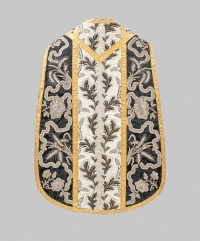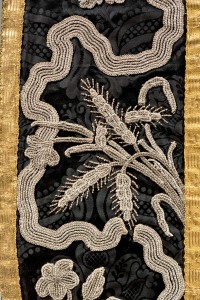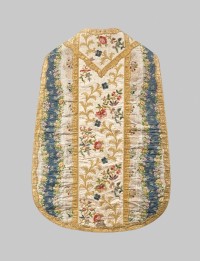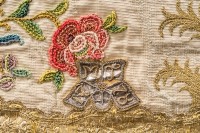 The Imperial Treasury at the Hofburg Palace in Vienna is home to an extraordinary collection of treasures accumulated by the House of Habsburg over hundreds of years. Jewels, vessels made of gold, silver and gemstones, furniture, paintings, the imperial regalia of the Holy Roman Empire and opulent vestments are on display in the Secular Treasury, including one of my favorite historic textiles of all time, the Mantle of Roger II, made in 1133-4 for the Norman king of Sicily. The crimson samite mantle was embroidered in gold by Arabic craftsmen in Palermo who created a breathtaking split scene of lions attacking dromedaries on both sides of a stylized date palm. It made its way to the Holy Roman Empire through marriage by the early 13th century and to Vienna in 1801.
The Imperial Treasury at the Hofburg Palace in Vienna is home to an extraordinary collection of treasures accumulated by the House of Habsburg over hundreds of years. Jewels, vessels made of gold, silver and gemstones, furniture, paintings, the imperial regalia of the Holy Roman Empire and opulent vestments are on display in the Secular Treasury, including one of my favorite historic textiles of all time, the Mantle of Roger II, made in 1133-4 for the Norman king of Sicily. The crimson samite mantle was embroidered in gold by Arabic craftsmen in Palermo who created a breathtaking split scene of lions attacking dromedaries on both sides of a stylized date palm. It made its way to the Holy Roman Empire through marriage by the early 13th century and to Vienna in 1801.
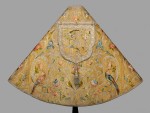 The Ecclesiastical Treasury features chalices, relics, monstrances, tabernacles and liturgical vestments. Its collection of 18th century religious textiles, most of which were donated to the Church by Emperor Charles VI, his wife Elisabeth Christine and their Empress Maria Theresa, mother of Marie Antoinette of France. The vestments were made of the most expensive French and Italian silks and satins that were then lavishly embroidered.
The Ecclesiastical Treasury features chalices, relics, monstrances, tabernacles and liturgical vestments. Its collection of 18th century religious textiles, most of which were donated to the Church by Emperor Charles VI, his wife Elisabeth Christine and their Empress Maria Theresa, mother of Marie Antoinette of France. The vestments were made of the most expensive French and Italian silks and satins that were then lavishly embroidered.
The extensive holdings of the Ecclesiastical Treasury in Vienna are largely unknown to the general public; they comprise mainly vestments and liturgical textiles that were used to celebrate Mass or during religious festivities. Totalling around 1,700 artefacts, the collection includes both sets of vestments and individual textiles. Many of these precious garments were donated by members of the House of Habsburg who for centuries ruled the Holy Roman Empire. The pomp and circumstance associated with this high office is reflected in the costliness of these sumptuous textiles, the finest of which date from the Baroque, the apogee of Habsburg piety. Unlike mediaeval ecclesiastical textiles, baroque vestments generally feature not figurative but purely ornamental decorations. Precious secular silks adorned with a variety of designs frequently function as the base material, which is then elaborately embellished with appliqués, lace or gold-, silver- and silk embroidery to produce opulent textile works of art.
The leading benefactress in the 18th century was Maria Theresia (1717-1780). She donated precious textiles for use in the imperial palace chapel and the chapels of the different imperial summer residences at Schönbrunn, Laxenburg and Hetzendorf, as well as in St. Augustine’s church in Vienna. The latter evolved into a major stage for Habsburg piety. Here newly-appointed bishops were invested. All these places were lavishly appointed with sumptuous ecclesiastical textiles.
These textiles are so fragile they are kept in conservation cabinets and cannot be on permanent display. Select pieces can be seen now in the special exhibition Praise of God, and the embroidery alone is mind-blowing.
